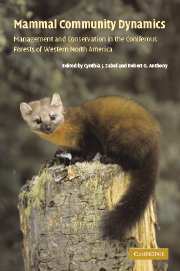 Mammal Community Dynamics
Mammal Community Dynamics Book contents
- Frontmatter
- Contents
- List of contributors
- Foreword
- Acknowledgments
- Part I Management and conservation issues for various taxa
- Part II Community and ecosystem relations
- 10 Relationships among fungi and small mammals in forested ecosystems
- 11 Ecology of coarse woody debris and its role as habitat for mammals
- 12 The ecological role of tree-dwelling mammals in western coniferous forests
- 13 The role of ungulates and large predators on plant communities and ecosystem processes in western national parks
- 14 The role of the lynx–hare cycle in boreal forest community dynamics
- 15 Associations of mammals with riparian ecosystems in Pacific Northwest forests
- Part III Conservation issues and strategies
- Index
- References
10 - Relationships among fungi and small mammals in forested ecosystems
Published online by Cambridge University Press: 15 December 2009
- Frontmatter
- Contents
- List of contributors
- Foreword
- Acknowledgments
- Part I Management and conservation issues for various taxa
- Part II Community and ecosystem relations
- 10 Relationships among fungi and small mammals in forested ecosystems
- 11 Ecology of coarse woody debris and its role as habitat for mammals
- 12 The ecological role of tree-dwelling mammals in western coniferous forests
- 13 The role of ungulates and large predators on plant communities and ecosystem processes in western national parks
- 14 The role of the lynx–hare cycle in boreal forest community dynamics
- 15 Associations of mammals with riparian ecosystems in Pacific Northwest forests
- Part III Conservation issues and strategies
- Index
- References
Summary
Introduction
Our approach
Here, we will present information about relationships between small mammals and an important food source, fruitbodies of (predominantly) ectomycorrhizal fungi. After providing some background on the function and diversity of the fungi involved, we will examine historical interest in mycophagy and current questions. The main focus will be on mycophagy (fungi consumption) and potential effects of disturbance on the interrelationships among trees, truffles, and mammals. We have not limited our discussion to western North America because much relevant research has occurred in Australia.
Mycorrhizae
Different plants form different types of mycorrhizae with different fungi. The Pinaceae are primarily ectomycorrhizal, the Cupressaceae primarily vesicular-arbuscular (VA) mycorrhizal, as are most herbaceous plants. Some genera or families, such as the Salicaceae, can regularly form both ecto- and VA mycorrhizae. The Ericales mostly have their own distinctive mycorrhizae, as do the orchids. The fungi that form these different mycorrhiza types have different dispersal strategies. Though general categories of mycorrhizae are usually defined in morphological terms with little regard to ecology (Smith and Read 1997) mycorrhizal associations can also be categorized ecologically – such as by the degree of dependence of tree species on mycorrhizae for growth and reproduction. This approach lends itself to inclusion of the spore dispersal mechanisms of the mycobiont in a broader ecological context (Trappe and Luoma 1992).
We will focus on ectomycorrhizal fungi (EMF) because those species seem to be the most important with regard to small mammal mycophagy.
- Type
- Chapter
- Information
- Mammal Community DynamicsManagement and Conservation in the Coniferous Forests of Western North America, pp. 343 - 373Publisher: Cambridge University PressPrint publication year: 2003
References
- 24
- Cited by


